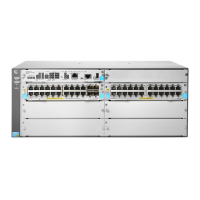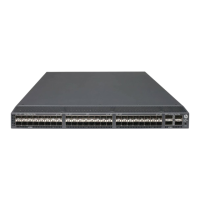45
RRPP ring
A ring-shaped Ethernet topology is called an RRPP ring. RRPP rings include primary rings and
subrings. You can configure a ring as either the primary ring or a subring by specifying its ring level.
The primary ring is of level 0, and a subring is of level 1. An RRPP domain contains one or multiple
RRPP rings, one serving as the primary ring and the others serving as subrings. A ring can be in one
of the following states:
• Health state—All physical links on the Ethernet ring are connected.
• Disconnect state—Some physical links on the Ethernet ring are not connected.
As shown in Figure 12, Do
main 1 contains two RRPP rings: Ring 1 and Ring 2. The level is set to 0
for Ring 1 and 1 for Ring 2. Ring 1 is configured as the primary ring, and Ring 2 is configured as a
subring.
Control VLAN and data VLAN
1. Control VLAN
In an RRPP domain, a control VLAN is dedicated to transferring RRPPDUs. On a device, the
ports accessing an RRPP ring belong to the control VLANs of the ring, and only these ports can
join the control VLANs.
An RRPP domain is configured with the following control VLANs:
{ One primary control VLAN, which is the control VLAN for the primary ring.
{ One secondary control VLAN, which is the control VLAN for subrings.
After you specify a VLAN as the primary control VLAN, the system automatically configures the
secondary control VLAN. The VLAN ID is the primary control VLAN ID plus one. All subrings in
the same RRPP domain share the same secondary control VLAN. IP address configuration is
prohibited on the control VLAN interfaces.
2. Data VLAN
A data VLAN is dedicated to transferring data packets. Both RRPP ports and non-RRPP ports
can be assigned to a data VLAN.
Node
Each device on an RRPP ring is a node. The role of a node is configurable. RRPP has the following
node roles:
• Master node—Each ring has only one master node. The master node initiates the polling
mechanism and determines the operations to be performed after a topology change.
• Transit node—On the primary ring, transit nodes refer to all nodes except the master node. On
the subring, transit nodes refer to all nodes except the master node and the nodes where the
primary ring intersects with the subring. A transit node monitors the state of its directly
connected RRPP links and notifies the master node of the link state changes, if any. Based on
the link state changes, the master node determines the operations to be performed.
• Edge node—A special node residing on both the primary ring and a subring at the same time.
An edge node acts as a master node or transit node on the primary ring and as an edge node on
the subring.
• Assistant edge node—A special node residing on both the primary ring and a subring at the
same time. An assistant edge node acts as a master node or transit node on the primary ring
and as an assistant edge node on the subring. This node works in conjunction with the edge
node to detect the integrity of the primary ring and to perform loop guard.
As shown in Figure 12,
Ring 1 is the primary ring and Ring 2 is a subring. Device A is the master
node of Ring 1. Device B, Device C, and Device D are the transit nodes of Ring 1. Device E is the
master node of Ring 2, Device B is the edge node of Ring 2, and Device C is the assistant edge node
of Ring 2.
Port
1. Primary port and secondary port

